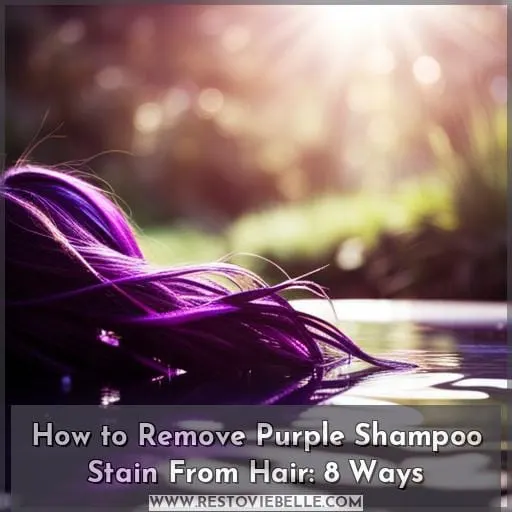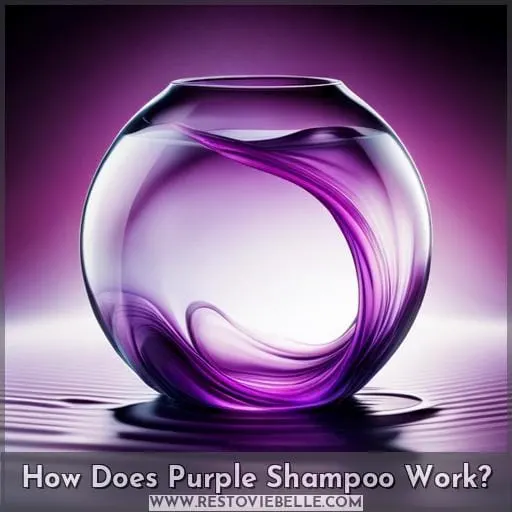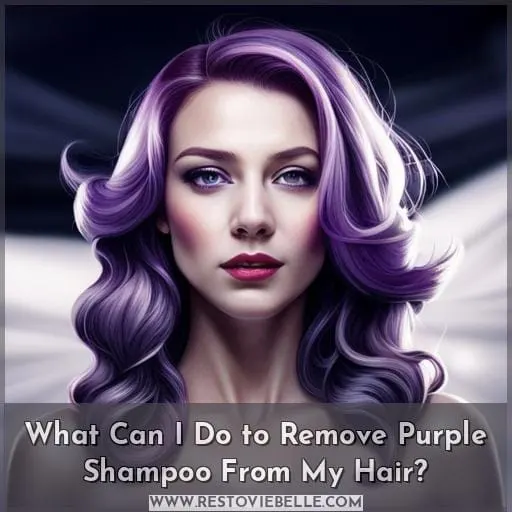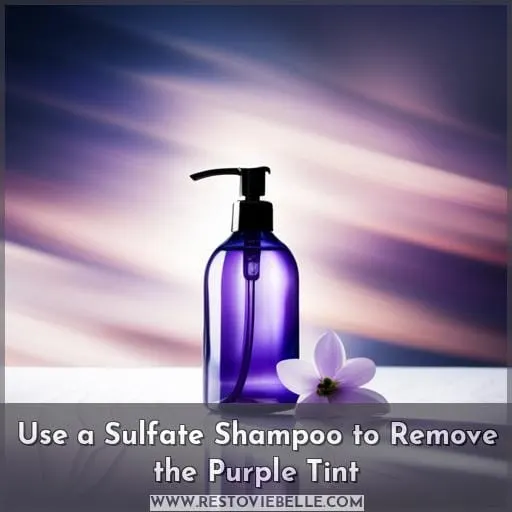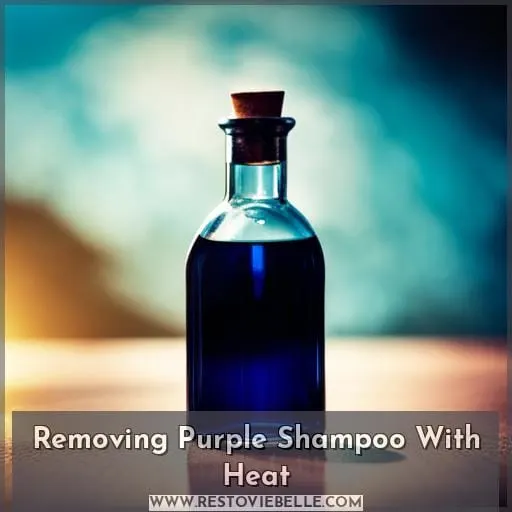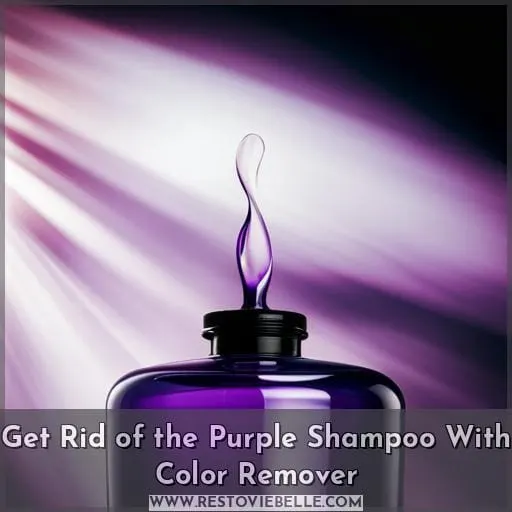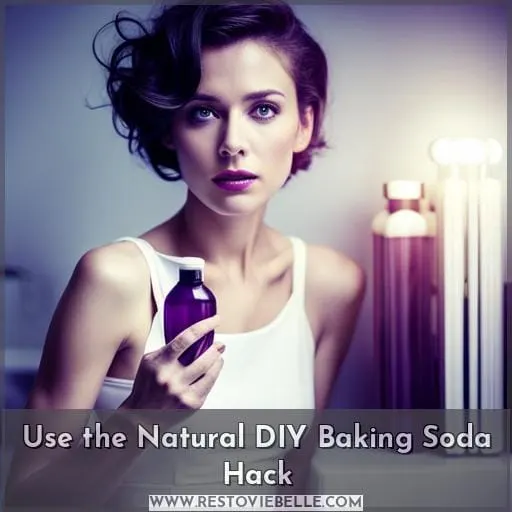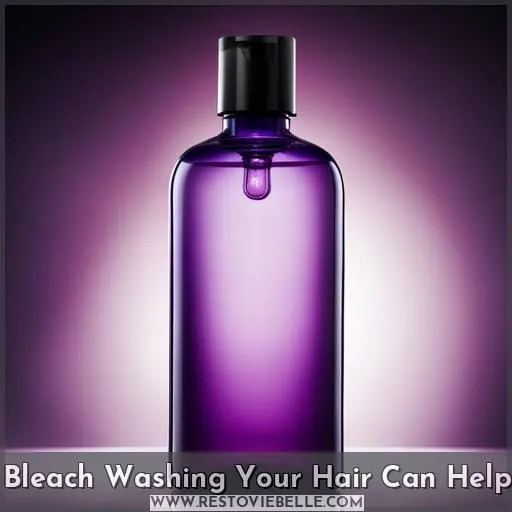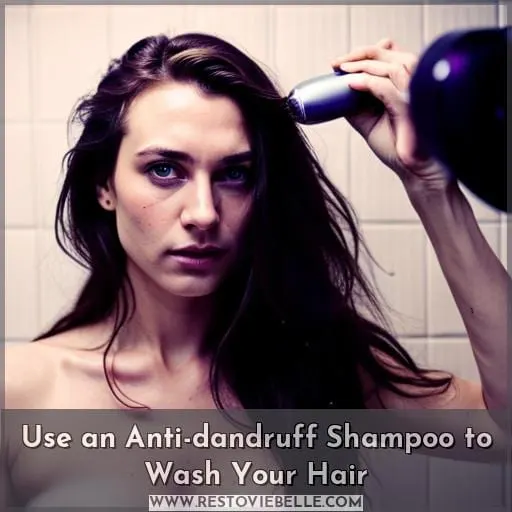This site is supported by our readers. We may earn a commission, at no cost to you, if you purchase through links.
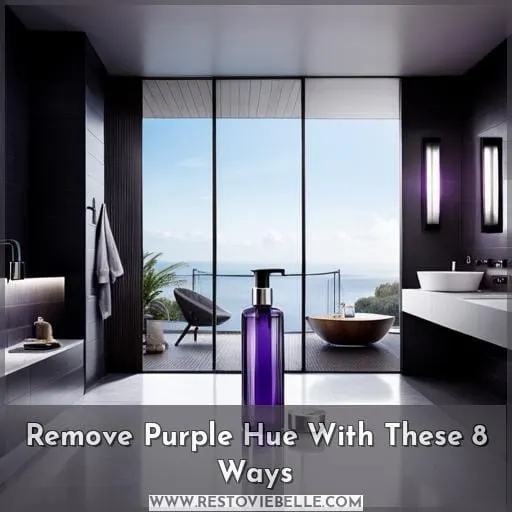 Are you stuck with a purple hue in your hair due to using too much of the purple shampoo? Don’t despair! You don’t have to jump straight into dyeing or bleaching your locks anew. Instead, there are several ways to remove the unfortunate tint without damaging your hair further.
Are you stuck with a purple hue in your hair due to using too much of the purple shampoo? Don’t despair! You don’t have to jump straight into dyeing or bleaching your locks anew. Instead, there are several ways to remove the unfortunate tint without damaging your hair further.
Table Of Contents
- Key Takeaways
- How to Remove Purple Shampoo Stain From Hair: 8 Ways
- How Does Purple Shampoo Work?
- What Can I Do to Remove Purple Shampoo From My Hair?
- Spray Your Hair With Lemon Juice
- Use a Sulfate Shampoo to Remove the Purple Tint
- Removing Purple Shampoo With Heat
- Get Rid of the Purple Shampoo With Color Remover
- Use the Natural DIY Baking Soda Hack
- Bleach Washing Your Hair Can Help
- Use an Anti-dandruff Shampoo to Wash Your Hair
- Conclusion
Key Takeaways
- Stop using purple shampoo immediately.
- Use clarifying shampoo to strip away the purple pigment.
- Mix baking soda with shampoo to neutralize the color.
- Apply hot water or a hair dryer for pigment release.
How to Remove Purple Shampoo Stain From Hair: 8 Ways
If you’re dealing with purple shampoo stains in your hair, the first step is to stop using purple shampoo immediately! To remove these staining effects, use a sulfate or pH-balanced shampoo followed by a clarifying wash.
Alternatively, opt for dandruff or anti-dandruff shampoos as they are gentler on the scalp and can effectively remove pigments from roots. Finally, baking soda mixed into regular shampoo can be used to neutralize any remaining color residue while restoring natural tones.
Stop Using Purple Shampoo!
If you’ve noticed purple stains in your hair, it’s time to stop using purple shampoo! Restore moisture balance and natural color with baking soda, lemon juice spray, and sulfate shampoos. Check porosity to prevent over-absorption of pigments; consider color removers or bleach washing if needed.
Hydrogen peroxide can lighten, but always use caution! Avoid common mistakes by following tips for safe and effective removal of the purple hue from the purple shampoo.
Use a Sulfate or PH-Balanced Shampoo
To remove the purple hue, use a sulfate or pH-balanced shampoo. Benefits include deep cleaning and stripping away pigments. Hair color maintenance becomes easier when dealing with stains. Cleansing with pH-balanced shampoo removes purple shampoo residue quickly and effectively while eliminating the tint from hair without having to resort to bleaching.
Use a Clarifying Shampoo
Try using a clarifying shampoo to deeply clean your hair and strip away the purple pigment. This will help remove all traces of purple pigments on the scalp and shafts of your hair. To avoid further staining, steer clear of green toners. After using the clarifying shampoo, make sure to hydrate your hair deeply for maximum results.
Regularly cleansing your hair will also help prevent any build-up. Lastly, protect your roots from absorbing too much color.
Use a Dandruff Shampoo
Dandruff shampoo is a gentle way to get rid of purple hue. It benefits your hair by removing any tint caused by purple shampoo with minimal damage. Color removal methods include testing porosity, using moisturizing conditioners, and other alternatives like dandruff.
Use Baking Soda
Mix baking soda with shampoo for a natural way to strip excess purple pigment. Baking soda has many benefits, but adding lemon juice helps the method work better. To further remove color, use sulfate shampoos and follow tips on usage and timing.
Hair dryer techniques also aid in releasing pigments from purple shampoo science. Finally, consider using hydrogen peroxide or color remover as a last resort if needed.
How Does Purple Shampoo Work?
Understand how purple shampoo works to get the right results – do you know what kind of hair color maintenance it provides? Purple shampoo helps remove yellow tones from blonde, gray, and white hair, but it can also lead to unintended tints if used incorrectly.
To avoid staining, use a salon-grade product according to your hair color level. Only leave it in for 2-3 minutes max, and rinse thoroughly after using. If stains occur, solutions for non-removable purple residues include sulfate or pH balanced shampoos, as well as baking soda mixed with shampoo.
Optimal usage should be 1-2 times per week, depending on your maintenance needs. Overusing may cause texture issues like dryness, which will require conditioning afterwards. Proper prevention includes avoiding bleaching and deep cleaning with clarifying shampoos.
With these strategies, you can unlock optimal purple shampoo usage while removing any unwanted residuals!
What Can I Do to Remove Purple Shampoo From My Hair?
If you’re trying to get rid of a purple hue from your hair, using a clarifying shampoo is an easy and gentle way to do it. For stronger hues, you can use the lemon juice method in combination with dish soap or baking soda for better results.
Another effective option is sulfate shampoo, which should be applied evenly across the scalp and left on for several minutes before rinsing well. Heat removal techniques, such as using hot water or blow drying, can also help activate any remaining purple pigments in your hair so they can be easily washed away.
To tackle stubborn residue, you may consider using color removers specially designed for removing dyes. However, keep in mind that these products contain bleach and may affect the existing colors in your locks.
Lastly, don’t forget to deep condition your hair after removing the purple shampoo. This will help keep your locks hydrated and healthy-looking without compromising their natural tone.
Spray Your Hair With Lemon Juice
Spray your hair with a lemon juice solution for an effective, natural way to lighten the purple hue caused by purple shampoo. Lemons are beneficial due to their acidic nature and their ability to gently remove color from the hair without causing damage.
It is important to understand your hair porosity as well. Porous strands may absorb too much pigment if left untreated or overused, leading to unwanted discoloration.
To use lemon juice, start by mixing equal parts of water and fresh-squeezed lemon juice in a spray bottle. Apply it evenly throughout dry or dampened locks, starting at the roots and working down towards the ends of the strands using an applicator brush for even distribution.
Leave the lemon juice solution on for no longer than 15 minutes before rinsing thoroughly with lukewarm water. Follow up with conditioner to restore moisture balance back into strands that have been stripped of oils from previous products used during the removal process, such as clarifying shampoos, dandruff treatments, or sulfate-based cleansers.
For more stubborn stains, consider color remover options, but use caution as they contain bleach, which could cause permanent changes in existing hues until fully removed. Deep conditioning after each treatment is highly recommended, especially when trying out different methods like baking soda mixes combined with regular shampoos.
Moisturizing conditioners also play an important role in restoring healthy vibrancy back into tresses and preventing further drying issues caused by stripping agents previously mentioned. They also aid immensely in removing any leftover residue left behind from all efforts taken thus far.
Use a Sulfate Shampoo to Remove the Purple Tint
Ready to take the next step in removing that pesky purple hue from your hair? Grab a sulfate shampoo and let’s get started! Sulfates are strong cleansers, working great for stripping away any purple shampoo residue.
Plus, they have added benefits as they can help reduce oil buildup on the scalp while also adding some body back into dull or lifeless locks.
To use a sulfate shampoo correctly, apply 2-3 pumps of it evenly throughout your tresses before letting it sit for several minutes and then rinsing thoroughly with lukewarm water. It is important to check your hair porosity though beforehand so you don’t strip away too much moisture.
After using a sulfate shampoo, make sure you follow up with a moisturizing conditioner – leaving no trace of that once unwanted color change caused by an incorrect usage of purple shampoos. This may still come along with certain considerations such as color remover solutions containing bleach, which might affect existing hues within our mane depending on how often applied or even hydrogen peroxide lightening treatments if needed at all.
Removing Purple Shampoo With Heat
If you want to quickly remove the purple hue from your hair caused by using purple shampoo, then hot water and a hairdryer are two excellent methods. To use hot water, wear a shower cap for 5-10 minutes before rinsing with warm or cold water; alternatively, using the hottest comfortable setting on a hairdryer can help release excess pigments in just a few minutes.
Using Hot Water
To remove the purple hue from your hair, try wearing a shower cap with hot water for 5-10 minutes – like Alicia did in her case study. Heat application helps release the pigments locked in by purple shampoo and can be used to strip away excess residue.
It is important to consider your hair porosity before using this method as heat may cause damage if applied too often or at an incorrect temperature setting. When done correctly, use a moisturizing conditioner afterwards for best results and protection against dryness that hot water effects can leave behind on porous strands of hair.
To avoid any potential damage, start gently by testing out different temperatures until you find one suitable for your own unique needs!
Using a Hair Dryer
Start styling with a hair dryer to help activate the purple pigment and reduce yellow tones from your locks! When using heat, start at scalp level on the lowest comfortable setting. Move slowly down each strand, avoiding contact with roots. This ensures even application of heat throughout all areas.
Use a nozzle attachment for more precise targeting of strands that need extra attention or are prone to damage. To prevent overdrying or staining, keep drying time minimal and finish off by deep conditioning afterwards.
Heat application is an effective way to remove purple shampoo residue without harsh chemicals used in other color removal methods like bleach washing or hair color removers.
Get Rid of the Purple Shampoo With Color Remover
It’s easy to go overboard with purple shampoo, leaving your hair tinted in an undesirable shade. If you have a stubborn purple hue caused by overuse of the product, it may be time to take more drastic measures such as using color remover.
Color removers are used to remove existing dye from the hair shaft and should be done cautiously due to their bleaching properties.
Here are some alternatives for removing unwanted hues:
- Bleach wash – mix bleach powder with developer or shampoo and apply gently; make sure not to leave on longer than recommended as this can damage your hair further
- Dishwashing liquid – use only a small amount diluted in warm water; rinse immediately afterwards
- Tint Remover – use specifically designed formulas that contain no bleach
- Hydrogen Peroxide/Vinegar Solution – mix equal parts peroxide and vinegar together and apply directly onto affected strands before rinsing thoroughly
These solutions will help rid you of excess pigments but won’t restore natural color back into your locks so post-shampoo care is important too! To prevent future mishaps, deep condition regularly after washing plus keep up regular trims at least every 6 weeks for healthy-looking locks!
Use the Natural DIY Baking Soda Hack
Try the natural DIY baking soda hack to easily neutralize any undesired purple hues in your hair. Baking soda has many benefits, including removing extra color from hair that’s been stained with purple shampoo.
With this DIY solution, you can prevent further staining and keep your hair looking its best.
To get started, check out an article section on how to determine your hair porosity level so you know what amount of baking soda is right for you! Mix a quarter cup of water and two tablespoons of baking soda together until it forms a paste-like consistency.
Leave it in for five minutes before rinsing thoroughly with warm water. This will help balance out the pH levels in your scalp while also preventing future stains caused by overuse or leaving too much product on at once.
For those who use purple shampoo regularly, consider using sulfate or pH-balanced shampoos every few weeks.
Remember to follow all instructions carefully if using color remover products since they contain bleach, which could drastically alter existing colors.
Bleach Washing Your Hair Can Help
Be aware that bleach washing your hair can help remove the unwanted purple hue from purple shampoo, however it may also dehydrate your locks. Bleach washing is a process of using hydrogen peroxide and water to lighten certain areas of the hair for color correction or highlights.
It should only be done with caution as this method can damage and dry out the strands if not applied correctly.
Alternatives to bleach washing include sulfate shampooing which strips away oils and colors, lemon juice spray for lighter shades, anti-dandruff shampoos as a gentle option for removing tinted hues, baking soda mixed with regular shampoo or applied alone to neutralize pigments – all followed by moisturizing conditioner recommendations after use.
To avoid unintended tints while still maintaining desired results consider toners such as those offered in salons alongside deep conditioning treatments afterwards too! Keep up on hair color maintenance tips through researching best practices online before diving into any techniques you’re unsure about; ultimately saving time & energy when pursuing perfect shades!
Use an Anti-dandruff Shampoo to Wash Your Hair
If you’re looking for a gentler way to get rid of purple shampoo stains, consider using an anti-dandruff shampoo. It contains milder ingredients than clarifying shampoos, which helps remove the excess color without stripping away too many natural oils from your hair.
You could also try baking soda or lemon juice spray as alternatives to strip out any unwanted purple hues.
After removing the residue with one of these methods, make sure you deep condition your hair to restore its shine and healthiness.
Here are some tips when washing with anti-dandruff shampoo:
- Use lukewarm water instead of hot; this helps retain moisture in both the skin and strands while effectively getting rid of stubborn residues.
- Massage the shampoo into the scalp gently before working through the lengths.
- Rinse thoroughly until all suds have been removed.
By taking these steps into account when dealing with remnants left behind by a purple shampoo application gone wrong, you’ll be able to keep those yellow tones at bay without damaging delicate locks!
Conclusion
Removing the purple hue from purple shampoo can be difficult, but it’s not impossible.
Stop using purple shampoo and alternate between a sulfate or pH-balanced shampoo, a clarifying shampoo, a dandruff shampoo, and baking soda for the best results. If your hair is still not back to its original color, try spraying it with lemon juice or using a sulfate shampoo.
You can also use heat to help release the purple pigments. This can be done by using hot water with a shower cap or using a hair dryer.
With these eight simple solutions, you can remove the purple hue from your hair caused by purple shampoo.
